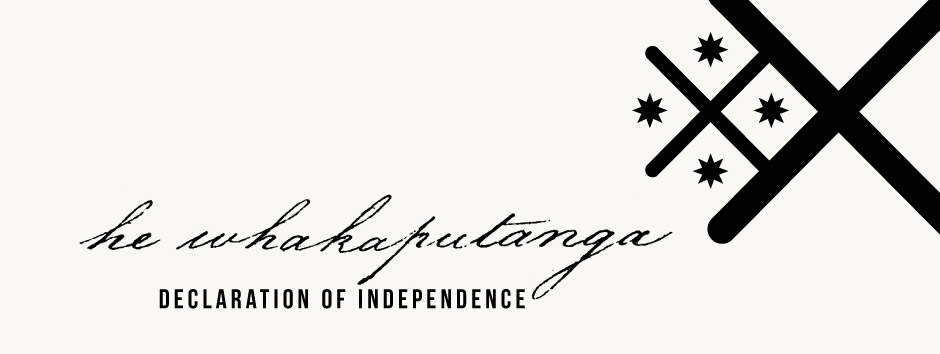Signing details
Rewa, also known as Mānu, was one of the principal rangatira of Ngāi Tawake, and Hongi Hika’s successor after Hongi’s death in 1828; historian Kathleen Shawcross suggests that in the 1830s he was second only to Tītore within Ngāpuhi’s northern alliance.
Rewa was probably born in the mid-to late 1790s at Mataraua, his ancestral lands south-west of Kaikohe. His mother was Te Auparo and his father was Hongi Hika’s second cousin, Te Maai (or Te Maoi). Historian Claudia Orange describes how Rewa’s father and two of his brothers were killed at the battle of Moremonui around 1807, and not long after, his mother and his sister Te Kārehu died in a Ngare Raumati attack on Te Waimate. Rewa and his descendants later took the hapū name Te Patukeha to remember his mother’s death, and in 1826 Rewa attacked Ngare Raumati and destroyed pā on Moturahurahu and Moturoa.
He had two wives: Te Koki, the cousin of Tītore, and a second wife brought back from battle. In the early 1820s Rewa’s daughter Matire Toha married Kati, a Waikato chief and brother of Te Wherowhero, in order to formalise peacemaking with Waikato.
In 1819 the Kerikeri mission station was established under the patronage of Hongi and Rewa. Rewa, who witnessed the 1819 deed for the mission, lived nearby with his brothers at a separate village to Hongi.
Rewa was often invited to breakfast at the mission, and in return provided very effective protection. He placed his daughter at the mission to learn to read and sew, and she was given the name Hannah, after missionary John Butler’s daughter. After Hongi’s death in 1828 it was Rewa who delivered his last wish: 'Do not hurt the missionaries. Let them remain quiet in their places and behave well towards them.' [1]
Rewa was also involved with the establishment of the mission station at Te Waimate. However, after the ‘Girls’ War’ of 1830, which in some accounts involved one or both of his daughters, he was mainly based at Kororāreka. He and Tītore had been steadily increasing their presence there, in direct competition with Pōmare II, Kiwikiwi and other Ngāpuhi allies. In the late 1820s Rewa had built a house at Kororāreka called Haratū (the site is now occupied by the Department of Conservation).
In September 1831 Rewa and the missionary William Yate returned from Sydney with news of an impending visit to Pēwhairangi (the Bay of Islands) by the French naval vessel La Favorite. Rumours quickly circulated that the French were coming to take the country and, after an important hui at Kerikeri, a letter to King William IV was written and signed by 13 rangatira, including Rewa. Rewa also signed He Whakaputanga, alongside his brothers Moka and Te Wharerahi, on 28 October 1835. A letter he wrote to the trader Thomas McDonnell in 1837 summed up his thoughts on these two documents: 'We are not like the King of England – we are all chiefs here.' [2]
According to Claudia Orange, 'after Tītore’s death in June 1837 Rewa became the undisputed principal chief of Kororāreka.' [3] While friendly with figures like Henry Williams, he was drawing away from the English missionaries. He became a protector of the Catholic mission and, although he signed Te Tiriti o Waitangi on 6 February 1840, actively tried to stop others from signing shortly afterwards: 'Send the man away; do not sign the paper; if you do, you will be reduced to the condition of slaves, and be obliged to break stones for the roads. Your land will be taken from you, and your dignity as chiefs will be destroyed.' [4]
During the 1845–46 Northern Wars, Rewa 'offered to help defend "his whites", and though he was arrogantly refused,' writes Orange, 'he nevertheless later supported the government with warriors.' [5] After the wars Rewa increasingly withdrew to the Rāwhiti area in the Bay of Islands.
He died on 1 September 1862, and is buried at Paripari urupā at Mataraua.
[1] Dorothy Urlich Cloher, Hongi Hika: Warrior Chief, Penguin Books, Auckland 2003, p.289.
[2] ‘Report on Stage 1 of the Te Paparahi o Te Raki Inquiry’, Waitangi Tribunal, Wellington, 2014, p.215, Waitangi Tribunal.
[3] Claudia Orange, ‘Rewa: Man of War, Man of Peace’ in Judith Binney (ed.), Te Kerikeri, 1770–1850: The Meeting Pool, Bridget Williams Books, Wellington, 2007, p.110.
[4] William Hobson to George Gipps, 5 February 1840, British Parliamentary Papers. Colonies: New Zealand, 1841 (311), p.8, Waikato University Library.
[5] Orange, ‘Rewa: Man of War’, p.111.


Community contributions